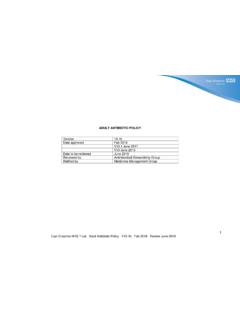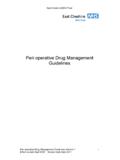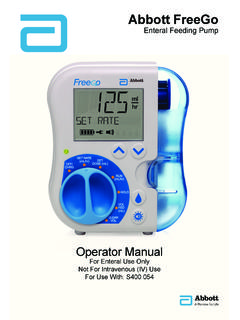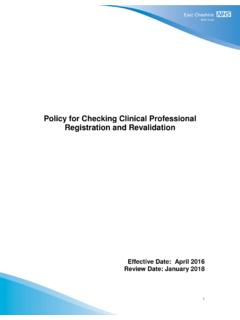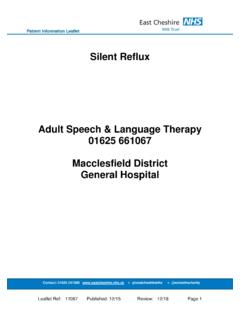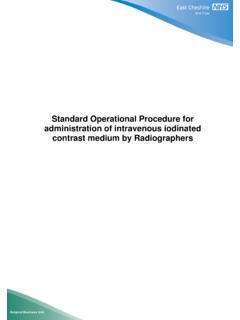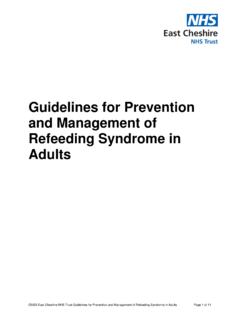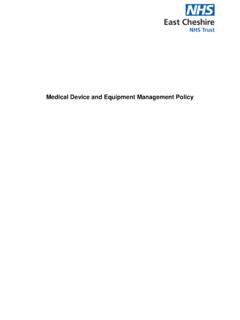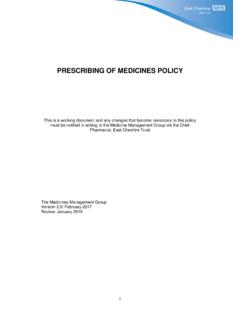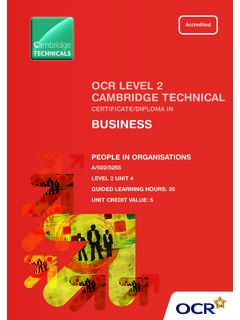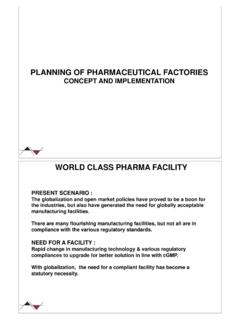Transcription of Guidance on the Acceptance Checking of Medical …
1 Guidance on the Acceptance Checking of Medical devices and equipment entering the organisation Version Date to be approved March 2017 Date to be reviewed March 2020 To be reviewed by Medical Engineering Manager 2 Document Title: Guidance on the Acceptance Checking of Medical devices & equipment entering the organisation Executive Summary: Acceptance checks are defined as those tests and checks that are performed on newly delivered Medical devices and equipment entering the organisation for the first time. These checks enable damaged, faulty or incorrectly supplied items to be identified at an early stage, thus minimizing any risk to the wellbeing of patients and staff before the items are used for the first time.
2 This Guidance applies to ALL Medical devices and equipment and includes equipment that is either purchased, leased, loaned, rented or on trial, whether they are electrically powered or not. Supersedes: Policy and Procedures for the Acceptance Checking of Medical devices and equipment entering the organisation . Description of Amendment(s): Simplification and review of existing policy to form Guidance document. This Guidance will impact on: All users of Medical devices and equipment . Financial Implications: Policy Area: Corporate Document Reference: ECT002703 Version Number: Effective Date: March 2017 Issued By: Medical Engineering Manager Review Date: March 2020 Author: (Full Job title ) Medical Engineering Manager Impact Assessment Date: N/A APPROVAL RECORD Committees / Group Date Consultation: Risk Management Sub Committee January 2017 Medical Device Facilitators January 2017 ECNHST Matrons January 2017 Approved by Committee: Risk Management sub-committee March 2017 Received for information: 3 Contents.
3 Section Title Page Introduction 4 Legislation and Guidance 4 Document purpose 5 Users responsibilities 5 Basic Guidance on delivery checks 5 Checks for portable electro-mechanical Medical devices / equipment 6 Checks for other Medical devices and equipment 7 Non-portable electro-mechanical Medical equipment 7 equipment loaned by manufacturers or other organisations 7 Document review 8 References 8 Appendices A Medical devices and equipment 9 B Flow chart 11 C End user checklist 12 4 1 Introduction The Medical devices Directive (MDD) 1998 harmonised the regulatory requirements for Medical devices within the EU, including the UK, and defines a Medical device as.
4 Any instrument, apparatus, appliance, material or article, whether used alone or in combination, including the software necessary for its proper application intended by the manufacturer to be used for human beings for the purpose of: Diagnosis, prevention, monitoring, treatment or alleviation of disease Diagnosis, monitoring, treatment, alleviation of or compensation for an injury or handicap Investigation, replacement or modification of the anatomy or of a physiological process, which does not achieve its principle intended action in or on the human body by pharmacological, immunological or metabolic means, but may be assisted in its function by such means.
5 Appendix A contains a non-exhaustive list of types of Medical devices and equipment . Acceptance checks are defined as those tests and checks that need to be performed on newly delivered devices and equipment as they enter the organisation for the first time. Simple checks on delivery can avoid trouble and save time. Finding out that a device is broken or inappropriate, only when someone tries to use it for the first time, can delay or interrupt treatment. It may also make it harder to establish where and when the problem arose and may invalidate warranties. There are risks to the wellbeing of patients and staff associated with not performing these tests before the items are put into use for the first time.
6 Therefore to minimize these risks, Medical devices and equipment MUST NOT be put into use before some form of Acceptance check has been performed. 2 Legislation and Guidance The MHRA recommends some form of Acceptance Checking for all new Medical devices and equipment entering a healthcare organization. Acceptance checks are used solely to minimize the risks associated with using newly delivered equipment , not to provide a belated critique of purchasing decisions .The quality, suitability, conformity to standards, running costs, user training and maintenance of the device or equipment MUST be addressed before purchase. Care Quality Commission: Guidance for providers on meeting the regulations (2015) references Regulation 15 of the Health and Social Care Act 2008 (Regulated Activities) Regulations 2014, in relation to devices and equipment used to help, prevent, treat or monitor a person s condition or illness, should be 1) Suitable for the purpose for which they are being used 2) Properly used 3) Properly maintained 5 East Cheshire NHS Trust has a duty of care towards its employees and patients and is required to ensure that they are not put at risk, from Medical devices or other equipment that is unsafe or unsuitable.
7 The Health and Safety at Work Act 1974 places a number of duties upon employers and employees concerning the requirements of safe working practices. In addition, The Electricity at Work Regulations 1989 state that electrical equipment should not be put into use which may give rise to danger and that all systems shall be maintained so as to prevent, so far as is reasonably practicable, such danger. There is a general duty to take necessary steps to protect staff and patients from danger. This includes the Acceptance Checking of Medical devices and equipment entering the organisation . 3 Document Purpose This document provides Guidance on how to manage and mitigate the risks associated with newly delivered Medical devices and equipment entering the organisation .
8 4 Users responsibilities ALL USERS OF Medical devices AND equipment All users of Medical devices and equipment are responsible for ensuring that appropriate Acceptance checks have been carried out before use of newly delivered Medical devices and equipment . Adverse incidents relating to Medical devices should be reported via the DATIX incident reporting system. Medical Engineering Team The Medical engineering team will be responsible for ensuring that newly delivered re-usable electro-mechanical Medical equipment is appropriately Acceptance checked and documented accordingly, following notification of receipt. Supplies Manager The Supplies Manager is responsible for ensuring that newly delivered Medical devices and equipment are compatible with the specifications set out in the purchase order.
9 He /she acts as primary liaison between the Trust and the equipment supplier in the event of damaged or inappropriately delivered equipment . 5 Basic Guidance on delivery checks It is essential that newly delivered devices and equipment are appropriately Acceptance checked in accordance with legislation and Guidance . This is to ensure that, where relevant: It matches the acquisition specification 6 It has been delivered in good condition and, where relevant, is in good working order It is supplied with the appropriate accessories and consumables It has all the necessary information and documentation, including instructions for use It is configured appropriately It is installed appropriately, where required It has been recorded on to the Trust s databases for Asset tracking Training needs have been identified and acted on For reusable devices , maintenance requirements have been identified and scheduled The MHRA state.
10 In their publication Managing Medical devices 2015 that Healthcare organisations should keep records of the purchase order, results of the delivery inspection, individual device or batch identifier and any safety or functional tests. Health and Safety Inspectors require these records to be available. The Medical Engineering Department manages the records for the reusable electro-mechanical equipment that it Acceptance checks or maintains, on a computerised database. It is therefore essential that Medical Engineering is contacted before any reusable electro-mechanical Medical equipment is used for the first time to ensure that the device can be checked and recorded on the database.

